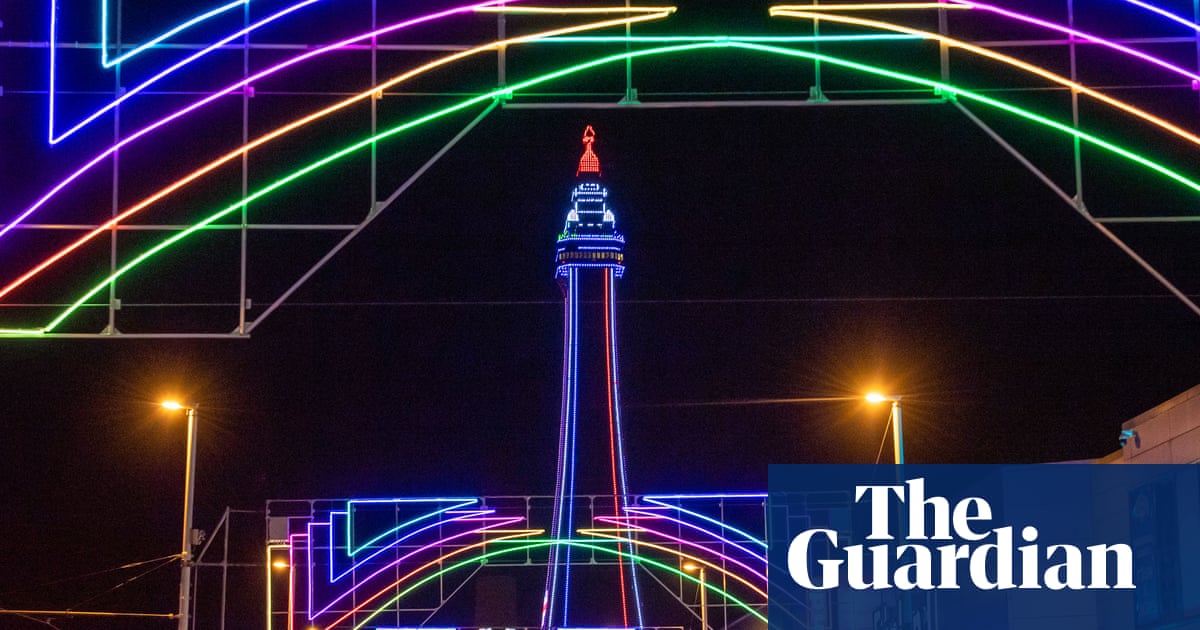When the pop star Olly Murs switches on Blackpool’s famous Illuminations next weekend, it will continue a tradition that has endured for almost a century and a half.
The Lancashire town was first lit up by twinkling bulbs 146 years ago – 12 months before Thomas Edison even patented the electric lightbulb.
The seaside resort has not been without its struggles, but the enduring popularity of the lights, which are switched on at the end of August every year, has helped to keep its tourism industry afloat.
Laurence Llewelyn-Bowen: ‘The British seaside does have an extraordinary place in everybody’s holiday legacy.’ Photograph: Channel 4
Laurence Llewelyn-Bowen, perhaps best known for his work on BBC programme Changing Rooms, and famed for his love of maximalist design, is this year marking 20 years of involvement with the illuminations, and is the event’s creative curator.
“It’s hilarious because people were very confused by it,” he said, “they’ve got this strange idea that somehow we’re turning on Christmas decorations, because they’ve got kind of no idea.”
Actually, Llewelyn-Bowen said, the illuminations are “the first ever, ever, ever, ever light festival; there was no electric light festival before that.” While globally there are now many more, including in Sydney, Lille and China, Blackpool is, he said, “the literal grande dame of all of that”.
This year his new installation is Guardians of the North, three seven-metre tall dragons, wrapped around turrets, which come alive with light, smoke and roving eyes.
“I love the idea that we can make the illuminations into this absolutely giant, free, illuminated art experience,” he said. “But not art that’s scary, not art that’s kind of turbulent, but just jolly art.”
One of the special things about Blackpool Illuminations, he said, was its enduring intergenerational appeal. While British seaside resorts are struggling amid tough competition from cheap overseas holidays, the lights remain, he said, “an incredibly strong part of people’s leisure heritage”.
“The British seaside does have an extraordinary place in everybody’s holiday legacy,” he said. “And this is something that we really focus on with the Blackpool experience.
“Come here and remember what it was like when you were your children’s age,” he added. “Come with your parents, come with your grandparents, use this as a way of coming together.”
The Blackpool Illuminations in 1954. Photograph: Mirrorpix/Getty Images
However, Llewelyn-Bowen said, while the illuminations have formed core memories for generations of children in the north-west in particular, the appeal of the lights has not spread widely beyond the Midlands; “It is a bit of a north-south divide,” he said.
“You get to a point where suddenly you just say ‘Blackpool’, and everyone starts getting rather misty-eyed,” he said, “and that carries on as far north as you can go, because it’s always been incredibly popular with the Scots as well.
“I always feel rather sorry for the poor mealy mouthed, magnolia-shaded Farrow and Ball-obsessed south,” he added. “Because they never really will get that, they will be kind of quite Brighton-centric, because somehow it’s cool, but actually, there’s nothing cooler than Blackpool, and nothing naughtier as well.”
Growing up in London, Llewelyn-Bowen said he himself was a latecomer to the illuminations. “I have no vestigial nostalgia for Blackpool,” he said. “Blackpool was never part of my childhood experience at all.”
However, he said, “it very quickly became part of my children’s childhood … and of course, a big thing now is that my grandchildren are obsessed by this whole thing. So I love the fact that it’s a contagion, that I kind of started myself.”
Thanks to his involvement with the illuminations, Llewelyn-Bowen is one of Blackpool’s fiercest advocates, but he was taken by the town even on his first visit, on a very wet November afternoon in the mid-1980s, when he was working for a flooring company, and sent up to the Winter Gardens.
“I just didn’t know that somewhere like this existed in the United Kingdom, somewhere where everywhere you looked there was so much design,” he said. “To me, it was like a jacked version of Portmeirion, but in such an incredibly kind of opulent, ornate way.
“I mean, Brighton’s got bits of embellishment, everywhere you go in Britain’s seaside-scape, you’ll find some curly, twirly piers, but Blackpool, literally you cannot spit without hitting a furbelow,” he added.
“I’ve always just felt that it is in such an incredibly stiff-upper-lip, strait-laced architectural nation, Blackpool is literally the only place, I think, where design really gets to take its bra off in this country, and really just do it for the shits and giggles.”
